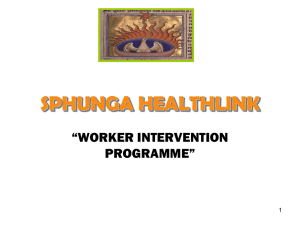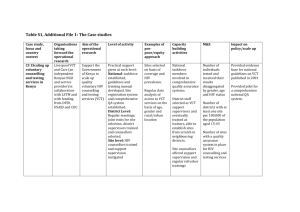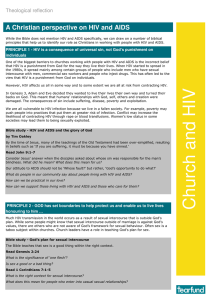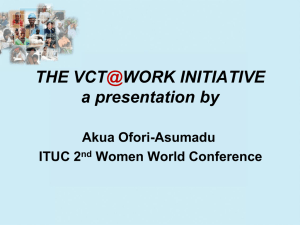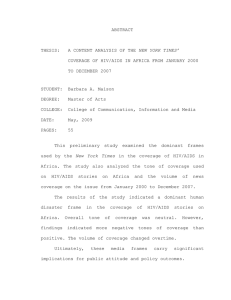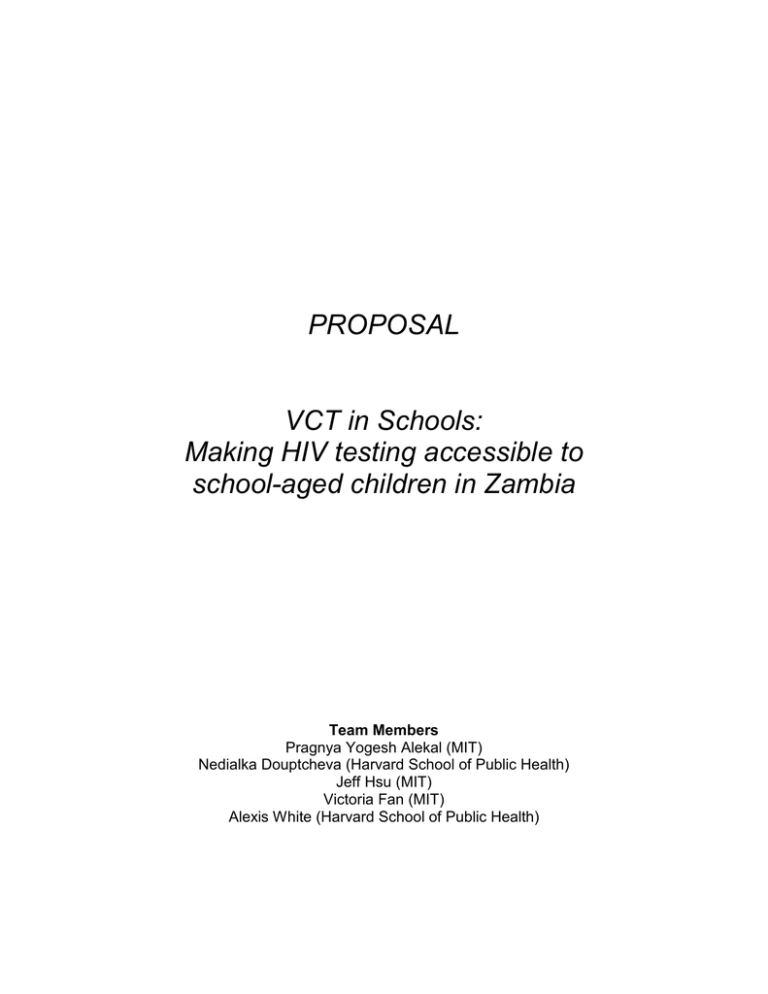
PROPOSAL
VCT in Schools:
Making HIV testing accessible to
school­aged children in Zambia
Team Members
Pragnya Yogesh Alekal (MIT)
Nedialka Douptcheva (Harvard School of Public Health)
Jeff Hsu (MIT)
Victoria Fan (MIT)
Alexis White (Harvard School of Public Health)
TABLE OF CONTENTS
I.
GOAL ............................................................................................................2
II.
STAKEHOLDERS .........................................................................................2
III. BACKGROUND ............................................................................................2
V.
1.
What is VCT ..............................................................................................2
2.
Why schools .............................................................................................2
3.
The need for VCT in Zambia....................................................................6
4.
VCT Models...............................................................................................7
5.
Components of a Youth VCT Program ...................................................9
6.
VCT Monitoring and Evaluation ............................................................10
7.
Considerations .......................................................................................10
PROPOSED WORK PLAN ......................................................................... 12
VI. MIT TEAM TASK LIST................................................................................13
VII. REFERENCES ............................................................................................15
1
I.
GOAL
To develop a pilot VCT program for secondary government schools in Lusaka,
Zambia. Such a program can serve as an enhancement to the already existing
HIV/AIDS education programs in schools, and will include pre- and postcounseling and testing services. The ultimate goal is to create a successful
model that can be replicated across the city, and possibly country.
II.
STAKEHOLDERS
•
•
•
•
•
•
•
•
III.
Ministry of Education
Ministry of Health / Central Board of Health
Zambian VCT centers
o Latkings Mobile VCT
Zambian peer education/sensitization organizations
o Ukani
Project Concern International (PCI)
School administrators/staff
School children
Parents
BACKGROUND
1. What is VCT
Voluntary counseling and testing (VCT) for HIV is a confidential, if not
anonymous, process that tests a person’s HIV status while providing pre- and
post-test counseling in order to help individuals make informed choices before
and after HIV testing. As an entry point to other HIV/AIDS services, VCT
supports individuals to access other HIV/AIDS related services, in particular, ART.
Access to and maintaining the quality of VCT services must be scaled up if the
target numbers of people are to have access to ART. VCT also serves as a
means of social education and public awareness raising.
2. Why schools
According to UNAIDS (2004), “Young people – 15-24 year olds – account for
nearly half of all new HIV infections worldwide. They are the largest youth
generation in history and need a protective environment – regular schooling,
access to health and support services – If they are to play their vital part in
combating the epidemic.”
2
Zambia is no different from other countries, and women are much more
susceptible to infection than men. Table 1 (HJKFF, 2005) shows how desperate
the need is. Between 16­25% of young women between the ages of 15­24 are
living with HIV. These are statistics that we cannot afford to ignore. According to
Avert (2003) “most Zambians become sexually active at quite a young age. In
2003, among young people 15­19 years old, 28% of boys and 44% of girls
reported having had sex within the last twelve months. The average age for first
sex is around 17 in females and 17.5 in males. It is normal for men to be older
than their partners; the average age difference is around 5 years. For many girls,
their first sexual encounter is with an older boy or elderly man, some of whom
entice them with money or gifts. This is one reason why girls aged 15­19 are six
times more likely to have HIV than are boys of the same age.”
Table 1: Indicators of HIV/AIDS in Zambia
Source: HJKFF, 2005
A study in Zambia found a marked decline in HIV prevalence rates in 15­ to 19­
year­old boys and girls with a medium to higher­level education, but an increase
among those with lower educational levels (Kelly, 2000).
Considering that HIV or sex itself is a subject rarely tackled in the home or
community, it is important that children have access to the information from
somewhere. Schools are arguably the best setting to provide children with
HIV/AIDS and sexual education because it is a pre­existing institution where
theoretically a large percentage of children attend. In addition, Avert claims, “Men
are targeting increasingly younger sexual partners whom they assume to be HIV­
negative, and the "virgin cure" myth (which claims that sex with a virgin can cure
AIDS) fuels much of the abuse.” A young girl, already scorned by society and
3
abused by the people she turns to, is unable to get information she might need.
In addition, breaking the cycle of myths starts with educating the next generation.
According to the World Bank (2002), “education is a proven means of stopping
the spread of HIV/AIDS… It has been proven to provide protection against HIV
infection… It is among the most powerful tools for reducing girls’ vulnerability.
Girls’ education can go far in slowing and reversing the spread of HIV by
contributing to female economic independence, delayed marriage, family
planning, and work outside the home. It offers a ready­made infrastructure for
delivering HIV/AIDS prevention efforts to large numbers of the uninfected
population – schoolchildren – as well as youth, who in many countries are the
age group most at risk. It is highly cost­effective as a prevention mechanism,
because the school system brings together students, teachers, parents, and the
community, and preventing AIDS through education avoids the major AIDS­
related costs of health care and additional education supply.”
Figure 1: Effects of education on HIV infection rates.
Source: World Bank (2002)
Education does more than just reduce HIV/AIDS transmission rates; it benefits
an entire country and community. It permeates well into other areas of a
student’s life, as can be seen from the figure below. This pictorial diagram
indicates the vicious cycle into which HIV/AIDS can trap a society. Education
seems the only way to break this cycle.
It is for this reason that we wish to focus on HIV/AIDS education programs in
schools. We believe that the need is desperate and can have the most long­term
benefit to the children and country in the end.
4
Figure 2: Effects of education on HIV prevalence rates among women.
Source: World Bank (2002)
5
Figure 3: Consequences of Inaction.
Source: World Bank (2002)
3. The need for VCT in Zambia
The Zambian Voluntary Counseling and Testing Services began to be
established in 1999, and by mid­2003 the country had at least 101 VCT centers
(Huddart 2004). Between October 1999 and May 2003, almost 386,000 clients
visited a VCT center, and more than 266,000 of these were tested (Huddart
2004). The overall HIV prevalence rate of those who were tested was 34%
(Huddart 2004).
A majority of “youth” or “young people,” which refers to those aged 15­24 years,
who engage in unsafe sex or other risky behaviors, are at risk of HIV infection.
This age group accounts for more than 50 percent of all HIV infections worldwide
(Boswell 2002:1). Preventing HIV among youth is particularly urgent in sub­
Saharan Africa, where young people comprise more than 30 percent of the
population and general HIV prevalence rates exceed 10 percent (Boswell
2002:1). In Zambia, young women had HIV prevalence rate in 1999 of 15.86 to
18.68, while young men had a prevalence rate of 7.08 to 9.32 (Boswell 2002:1).
Given these statistics, the problem of increasing HIV infection rates among
young people in Zambia needs to be addressed, and the introduction of
accessible VCT services would be an effective way to meet these needs.
6
4. VCT Models for Young People
Few countries have VCT services specifically developed for young people
(Boswell 2002:2). Young people have different needs and seek out VCT
services for different reasons. Some countries now acknowledge the importance
of targeting youth through VCT (Boswell 2002:2). Furthermore, few services
have been developed to help high­risk young people in developing countries.
Barriers to Youth VCT Services (Boswell 2002:15; Morin)
• Expense and travel time
• Availability and acceptability of VCT services
• Waiting time
• Costs and pressure by health staff to notify partners
• Worries about confidentiality and fear that results will be shared
without consent
• Inaccurate risk perception
• Worries about stigmatization by family, friends, community
• Perceptions of consequences of those living with HIV
• Inadequate response from healthcare providers to meet HIV
prevention, care and support for youth
Key Features of Youth VCT Services
Boswell (2002) identified key features of youth­friendly health services that
include:
• Full participation of young people in decision making, planning and
delivery of services
• Community mobilization to increase understanding of young people’s
health needs
• Peer education through community outreach and clinic­based
educators and compensation packages to ensure participation and
motivation
• Designated “youth­friendly corners” at clinics and freestanding VCT
sites
• Health providers trained in youth­friendly approaches to
communication and counseling
• Suitable accommodation ensuring discretion for issues of consent and
disclosure
• Integration with other post­test health and psychosocial support
services
• Confidentiality
• Adequate supplies of condoms, IEC materials and drugs
7
General Youth VCT Models (Boswell 2002)
Type of Model
Integration in primary
health care
Integrated into school
and college healthcare
services
Integrated with TB and
ARV services
Integrated with STI
services, family planning
clinics
Youth centers
Mobile services
Private sector
Home testing
What We Know
Young people are often
reluctant to attend formal
health services. As a
result, youth­friendly
health services (YFHS)
may more effectively
influence behavior and
knowledge.
A US study suggests that
school­based clinics may
provide easier access to
VCT than other formal
health settings.
VCT can be offered to
receiving TB services.
Issues of confidentiality,
testing quality, and
adequate referral
networks are major
issues
Mobile VCT have been
developed to access
hard­to­reach individuals
through a van that makes
scheduled visits, but
research suggests limited
uptake by youth.
Private health
practitioners
Home test kits may help
issues of confidentiality
Issues for Consideration
VCT and counseling can
be integrated into YFHS,
but there is no evidence
that shows YFHS
successfully increases
youth use of health
services.
This may not translate
well to developing
countries and also limits
the population to those in
school.
Low uptake since youth
do not favor services
within hospitals and
clinics due to service
provider attitudes, access
issues such as parental
consent for services and
judgmental approaches.
Takes advantage of
youth culture through
music and drama
The Kitovu Hospital
Mobile Care Program in
Uganda makes rural
outpost visits and offers
same­day VCT services
at a local school for
youth.
Results may be
misinterpreted and
update of referral
networks are reduced.
8
5. Components of a Youth VCT Program
Youth Education
• Train teachers to teach sexual and reproductive health in the
classroom
• Involve students in curriculum design
• Involve parents in a parallel but separate course
• Refer students to the clinic
• Peer education sessions with sketches, videos on behavior­change
communication, condom demonstration
Clinical Services
• Open a VCT site that offer VCT as stand­alone services. Huddart
(2004) found that stand­alone services attracted more clients. How this
affected youth participation is not clear.
• Keep the clinic open daily with flexible times for adolescents, after
hours, on weekends, through lunch breaks
• “Same­hour” HIV testing using simple/rapid tests
• Consistent and regular supply of testing kits
• Minimum waiting times
• Confidential, if not anonymous service
• Adolescent­friendly or –sensitive materials on sexual and reproductive
health
• Provide free VCT, both pre­ and post­testing counseling to adolescents
• Available and ongoing preventive and supportive individual and family
counseling
• Ensure that referral networks and access to partner organizations TB
information and preventive care, hospice care, home care, STI
screening, treatment and management, violence and abuse, mental
health problems
• Ensure regular training, supervision, and monitoring of counselors to
ensure high­quality VCT by working with the Zambia Voluntary
Counseling and Testing Services (ZVCTS) based at UTH in Lusaka
that oversees VCT services. With the number of VCT centers now
exceeding 100, this responsibility appears impossible to fulfill (Hubbart
2004)
Prevention
• Free (WHO) or low­cost (Maximum/Reality) condoms
• Support for employment or income­generating activities
• Skills training for orphans
Public Awareness and Social Marketing
• Awareness­raising and VCT mobilization
• Recreational activities and correspondence with youth through sports
centers
• Promotional competitions and prizes
9
• Publicity campaign through posters, billboard and media spots. When
former Zambian president Kaunda lost his son in the 1980s, he took a
personal and open stand against the pandemic. Since then, he has
given AIDS prevention public service announcements promoting
openness about HIV/AIDS, abstinence, mutual fidelity, condom use,
VCT, and compassion for those living with HIV/AIDS television and
radio spots.
• Youth newspaper
• Advertising and community mobilization
• Lobby public officials
Other Issues
• Selection of a positive name and logo, eg, Hope House, New Start,
Hope Humana, Winning through Caring, etc.
6. VCT Monitoring and Evaluation
Desired Outcomes after Program Completion
• After completing the program, do individuals have more knowledge,
responsibility, and maturity towards sexuality?
• Do individuals become sexually active later?
• Do individuals increase use of contraception?
• Does the number of unwanted pregnancies decrease?
• Does VCT help individuals make therapeutic changes in their sexual
behavior
• Do individuals access support services?
• Do counselors fulfill all requirements of pre­ and post­testing?
7. Considerations
While testing for HIV in schools is highly desirable for increasing knowledge of
individual status and the attending behavioral changes that this knowledge
typically triggers, it raises some considerations related to testing children that
must be addressed before implementation. By general definition, children, as a
group, include all people less than 18 years of age. This group receives special
attention and rights under the Convention on the Rights of the Child, given their
vulnerable status in most societies. As such, we must be careful not to propose
an intervention that might jeopardize this protected status. This includes
ensuring that proper parental consent is obtained prior to VCT, if we determine
that this will improve and not hinder the outcomes for the children. This has
debatable ramifications; some people claim that parental involvement will limit
the number of students who seek VCT, as children who are sexually active may
not want their parents to know about their sexual activity. Conversely, others
claim that to place children in a situation where they may discover that they have
10
a fatal disease without the involvement of their family support network is
unthinkable. Both of these points require further consideration and a better
understanding of individual settings, norms, and trends will determine to what
extent each should be accommodated in actual programming.
When designing an HIV testing program for a school­based setting we must be
conscious not only of children’s emotional capacity to deal with the reality of HIV
but also of how they will, as individuals, manage the knowledge of their HIV
status. As the years between 12 and 18 are very important developmentally, and
children in this age group display a broad range of coping skills, emotional
understanding, and communication ability, it is imperative to have child­centered
counseling to accompany the testing program. This child­specific VCT should be
part of a much larger HIV education program, so that sensitization to PLWHA is
already underway and potential stigma can be minimized. We must also ensure
that child confidentiality is appropriately addressed in the design of our VCT
program. The chance that individual HIV status could become public information
at the school would endanger both the students themselves and the success of
the program. It should be understood at the outset that the school is simply a
venue for providing VCT to an important audience and the school should remain
an indifferent party to the outcome. Otherwise, if the school was involved beyond
that, there is the chance that administrators or teachers may start to treat HIV­
positive students differently.
Finally, to maximize the chance for successful integration of VCT into schools it
will be crucial to obtain input and support from teachers, school administrators,
students, and parents from the earliest phases of program design. If any one of
these groups feels that their opinions and interests are not considered, their lack
of cooperation could create major obstacles to implementing VCT in schools.
Each has an important perspective and a common understanding is essential to
program success. Short of requiring mandatory testing for all students, the hope
for VCT in schools rests on the ability of these groups to come together to agree
how to best serve the health needs of the children.
These ideas illuminate some other important related issues. Though we may feel
that there is a moral obligation to test all children, we must be mindful that
international human rights laws prohibit mandatory testing. Instead, we can rely
on the recent precedent set by the partnership between the WHO and the
Lesotho Ministry of Health and their initiative to voluntarily test every resident
over the age of 12 by the end of 2007. We must also be aware of the potential of
information networks, as children in schools participating in VCT programs will
share information with children and adults not in school. How this is handled will
have significant implications on the success of the program, as it is an important
outlet for information sharing, but may have a significant impact on program
capacity. Therefore, it must be decided up­front whether non­enrolled children,
parents, and other members of the community can come to participating schools
for testing.
11
V.
PROPOSED WORK PLAN
We are encouraged by the recent partnership between three NGOs in Lusaka,
Project Concern International (PCI), Ukani, and Latkings, and how their pilot
program addresses many of the issues discussed in the Considerations section,
specifically, the importance of providing a comprehensive and synergistic
package of youth­focused HIV education, sensitization, and VCT to children in
schools. Their program has incorporated the expertise of these three
organizations to provide a comprehensive HIV education and testing workshop
for students in community schools: HIV education from PCI, peer and parent
education and sensitization from Ukani, and VCT from Latkings.
In the pilot test of this partnership at St. Mary’s School in November, PCI
provided HIV education, Ukani conducted a three­week education/sensitization
module for students, a one­day workshop for parents, and Latkings’ counselors
were able to test 250 people in one day, both students and their parents and
caretakers. The program was very well received by both students and
parents/guardians. Given the success of this pilot program in the Kafue district of
Zambia, we propose to function as a coordinator to support the ongoing,
collaborative work of these organizations.
As the current program relies on existing relationships with schools, we would
conduct a needs assessment to expand the reach of their programs and VCT
access for schoolchildren. This would involve surveying schools in Lusaka and
the surrounding areas, assessing their existing HIV curriculum, determining the
school’s level of interest in and commitment to providing VCT in the school, and
coordinating the timing for the education, training, and VCT. Following the
program lead, we would identify the most vulnerable populations first, focus our
efforts on bringing services to them, and expand to less vulnerable populations
once these children have received adequate care. Ideally, with time and proven
success, we can expand this type of program throughout the country.
Testing Guidelines
Given that 16 is the current government age requirement for parental/guardian
consent, we must address the issue of how to appropriately test children under
age 16. We feel that the 13­16 year­old age group is especially important to
reach with VCT as at 13 children are still in a relatively low risk group. As we
have mentioned previously, it is within the 13–16 age range that many children
make their sexual debut and need to be informed about their risks of contracting
HIV. However, the main objective in undertaking this new project is to do so in a
way that minimizes potential harm to participants. Therefore, while we agree that
testing as many people as possible is the ideal, without an explicit change in the
law we should not recommend testing children less than 16 years of age without
the consent of a parent or guardian. To make an exception for HIV testing, while
possibly beneficial on an individual level, could set a precedent that would have
far greater, potentially negative ramifications for children as a group.
12
That said, we appreciate the importance of testing as many children as possible,
so would like to find a way to ease the consent process. Oral consent from the
parent or guardian seems adequate, if there is a way to document it. We do not
think that passing the consent obligation along to the teacher is appropriate, as it
will not ultimately be the teacher who is responsible for helping the child cope,
whatever the outcome of his or her test. As part of our assessment we will
create a system to consistently document oral consent.
Overall, we feel that VCT should be available to any child that wishes to
participate. However, we as adults also have an obligation to protect children.
Through the multi­faceted components of this partnership, even when a child
cannot legally obtain testing without parental consent until he or she is 16, at
least they will have education and sensitization that might help reduce their risk
of contracting HIV in the interim. To ensure adherence to these consent
guidelines, we will introduce a system to track and document consent for children
under age 16.
Evaluation
Ongoing evaluation of this program will be crucial, to ensure that we are
providing a valuable service in a way that is improving equitable access to HIV
education, counseling, sensitization, and testing. This will involve interviews and
surveys with participants, including school administrators, healthcare providers,
students, and parents. We will also conduct workshops with people providing
VCT services to collect feedback and work with them to make their program as
child­focused as possible.
Additionally, we will evaluate the validity of our consent tracking process, and
work through ways to increase testing where legally possible.
VI.
MIT TEAM TASK LIST
The role of the MIT team in Zambia will be to facilitate the relationships between
schools, educators, VCT providers, and HIV awareness building efforts. We will
work within the existing partnership of Ukani, Latkings, and PCI to enhance their
current projects and expand their reach in Zambia.
To this end, we have identified the following tasks:
a. Identify point person in Zambia to work on needs assessment and project
coordination
b. Develop needs assessment tool to identify schools in need and prioritize
list by most vulnerable
c. Establish relationships with schools and coordinate the
introduction/enhancement of HIV curriculum between Ukani, PCI, and
Latkings
d. Plan education programs, ensure commitment of schools, and set up VCT
days following education module
13
e. Create a standardized documentation process for parental consent for
children less than 16 years of age. This will include a method to track oral
consent. It will also determine how to deal with consent in situations
where there may be children that have no parent(s), and possibly no
guardian.
f. Evaluate ongoing programs to ensure that children are receiving child­
sensitive counseling, follow­up care for HIV positive children, and family
support. In instances where family support is not considered adequate
(or we determine that a child’s test status has had a negative impact on
their care), we will have to determine an appropriate alternative.
Throughout this program, we must remain focused on the effort to expand
services, both education and VCT, in a way that reaches as many people as
possible, but to do so in an equitable, accessible, and responsible manner.
14
VII.
REFERENCES
Avert (2003), HIV and AIDS in Zambia: The Epidemic and its Impact,
http://www.avert.org/aids­zambia.htm . Accessed November 13, 2005.
Boswell, Deborateh and Rachel Baggaley. 2002. VCT Toolkit: Voluntary
Counseling and Testing and Young People: A summary overview. Family Health
International. <www.fhi.org>
Esu­Williams, Eka, Katie Schenk, Joseph Motsepe, Scott Geibel, and Anderson
Zulu. 2004. Involving Young People in the Care and Support of People Living
with HIVS and AIDS in Zambia. The Population Council.
Huddart, Jenny, Rebecca Furth, and Joyce Lyons, of Initiatives, Inc. 2004. The
Zambia HIV/AIDS Workforce Study: Preparing for Scale­up. University Research
Co. <www.qaproject.org>
Kelly, M. J. (1999). The Impact of HIV/AIDS on Schooling in Zambia. Paper
presented at the XIth International Conference on AIDS and STDs in Africa,
Lusaka, Zambia.
Kelly, M.J (2000). The Encounter between HIV/AIDS and Education. Harare,
Zimbabwe: UNESCO, Sub­Regional Office for Southern Africa.
Morin, Steve and Gertrude Khumalo­Sakutukwa. The Feasibility of Community­
Based VCT in Zimbabwe. AIDS Policy Research Center.
The Henry J. Kaiser Family Foundation (HJKFF) (October, 2005), HIV/AIDS
Policy Fact Sheet: The HIV/AIDS Epidemic in Zambia,
http://www.kff.org/hivaids/upload/7369.pdf, Accessed November 14, 2005
UNAIDS (2004), Executive Summary: 2004 Report on the Global AIDS Epidemic,
http://www.unaids.org/bangkok2004/GAR2004_html/ExecSummary_en/Execsum
m_en.pdf, Accessed November 14, 2005
UNAIDS. 2000. Voluntary Counseling and Testing (VCT). UNAIDS Technical
update.
Walkowiak, Helena and Michael Gabra of Management Sciences for Health.
2002. VCT Toolkit: Commodity Management in VCT Programs: a planning guide.
Family Health International www.fhi.org
World Bank (2002), Education and HIV/AIDS: The Window of Hope,
http://www1.worldbank.org/education/pdf/Ed%20&%20HIV_AIDS%20cover%20p
rint.pdf, Accessed November 13, 2005
15
MIT OpenCourseWare
http://ocw.mit.edu
EC.S11 Engineering Capacity in Community-Based Healthcare
Fall 2005
For information about citing these materials or our Terms of Use, visit: http://ocw.mit.edu/terms.

